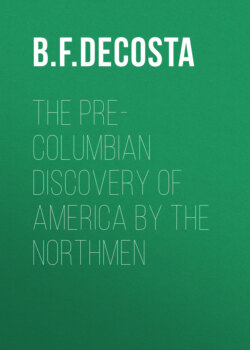Читать книгу The Pre-Columbian Discovery of America by the Northmen - B. F. DeCosta - Страница 12
На сайте Литреса книга снята с продажи.
THE COLONIZATION OF ICELAND.
ОглавлениеIn the cold north sea, a little below the arctic circle, lay a great island. As early as the year 860, it had been made known to the Northmen by a Dane of Swedish descent named Gardar, who called it Gardar's island, and four years later by the pirate Nadodd, who sailed thither in 864 and called it Snowland. Presenting in the main the form of an irregular elipse, this island occupies an area of about one hundred and thirty-seven square miles, affording the dull diversity of valleys without verdure and mountains without trees.[22] Desolation has there fixed its abode. It broods among the dells, and looks down upon the gloomy fiords. The country is threaded with streams and dotted with tarns, yet the geologist finds but little evidence in the structure of the earth to point to the action of water. On the other hand, every rock and hillside is covered with signs that prove their igneous origin, and indicate that the entire island, at some distant period, has already seethed and bubbled in the fervent heat, in anticipation of the long promised Palingenesia. Even now the ground trembles in the throes of the earthquake, the Geyser spouts scalding water, and the plain belches mud; while the great jokull, clad in white robes of eternal snow—true priest of Ormuzd—brandishes aloft its volcanic torch, and threatens to be the incendiary of the sky.
The greater portion of the land forms the homestead of the reindeer and the fox, who share their domain with the occasional white bear that may float over from Greenland on some berg. Only two quadrupeds, the fox and the moose, are indigenous. Life is here purchased with a struggle. Indeed the neighboring ocean is more hospitable than the dry land, for of the thirty-four species of mammalia twenty-four find their food in the roaring main. The same is true of the feathered tribes, fifty-four out of ninety being water fowl. Here and there may be seen patches of meadow and a few sheep pastures and tracts of arable land warmed into fruitfulness by the brief summer's sun; yet, on the whole, so poor is the soil that man, like the lower orders, must eke out a scanty subsistence by resorting to the sea.
It was towards this land, which the settlers called Iceland, that the proud Norwegian jarl turned his eyes, and there he resolved to found a home.
The first settler was Ingolf. He approached the coast in the year 875, threw overboard his seat-posts,[23] and waited to see them touch the land. But in this he was disappointed, and those sacred columns, carved with the images of the gods, drifted away from sight. He nevertheless landed on a pleasant promontory at the southeastern extremity of the island, and built his habitation on the spot which is called Ingolfshofdi to this day. Three years after, his servants found the seat-posts in the southwestern part of the island, and hither, in obedience to what was held to be the expressed wish of the gods, he removed his household, laying the foundation of Reikiavik, the capital of this ice-bound isle. He was rapidly followed by others, and in a short time no inconsiderable population was gathered here.
But the first settlers did not find this barren country entirely destitute of human beings. Ari Frode,[24] than whom there is no higher authority, says: "Then were here Christian people, whom the Northmen called papas, but they afterwards went away, because they would not be here among heathens; and left behind them Irish books, and bells, and croziers, from which it could be seen that they were Irishmen." He repeats substantially the same thing in the Landanama Book, the authority of which, no one acquainted with the subject, will question, adding that books and other relics were found in the island of Papey and Papyli, and that the circumstance is also mentioned in English books. The English writings referred to are those of the Venerable Bede. This is also stated in an edition of King Olaf Tryggvesson's Saga, made near the end of the fourteenth century.[25]
The monks or Culdees, who had come hither from Ireland and the Isles of Iona, to be alone with God, all took their departure on the arrival of the heathen followers of Odin and Thor, and the Northmen were thus left in undisputed possession of the soil. In about twenty years the island became quite thickly settled, though the tide of immigration continued to flow in strongly for fifty years, so that at the beginning of the tenth century Iceland possessed a population variously estimated from sixty to seventy thousand souls. But few undertook the voyage who were not able to buy their own vessels, in which they carried over their own cattle, and thralls, and household goods. So great was the number of people who left Norway at the outset that King Harold tried to prevent emigration by royal authority, though, as might have been predicted, his efforts were altogether in vain. Here, therefore, was formed a large community, taking the shape of an aristocratic republic, which framed its own laws, and for a long time maintained a genuine independence, in opposition to all the assumptions and threats of the Norwegian king.
